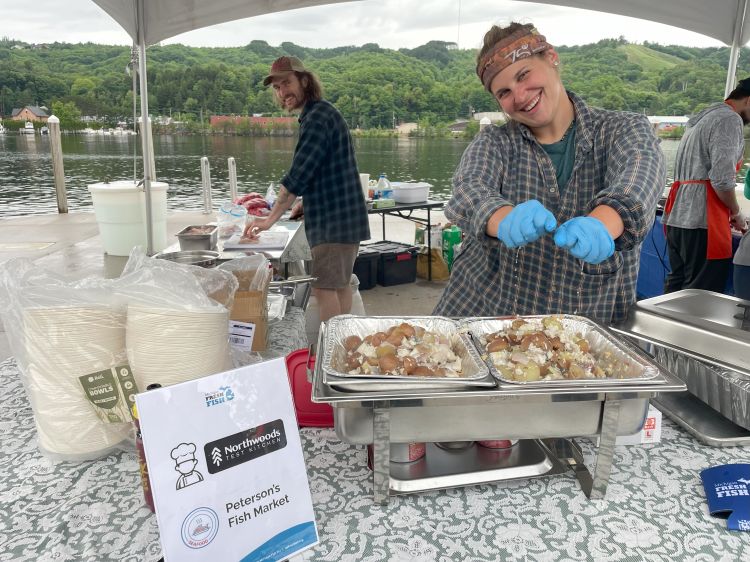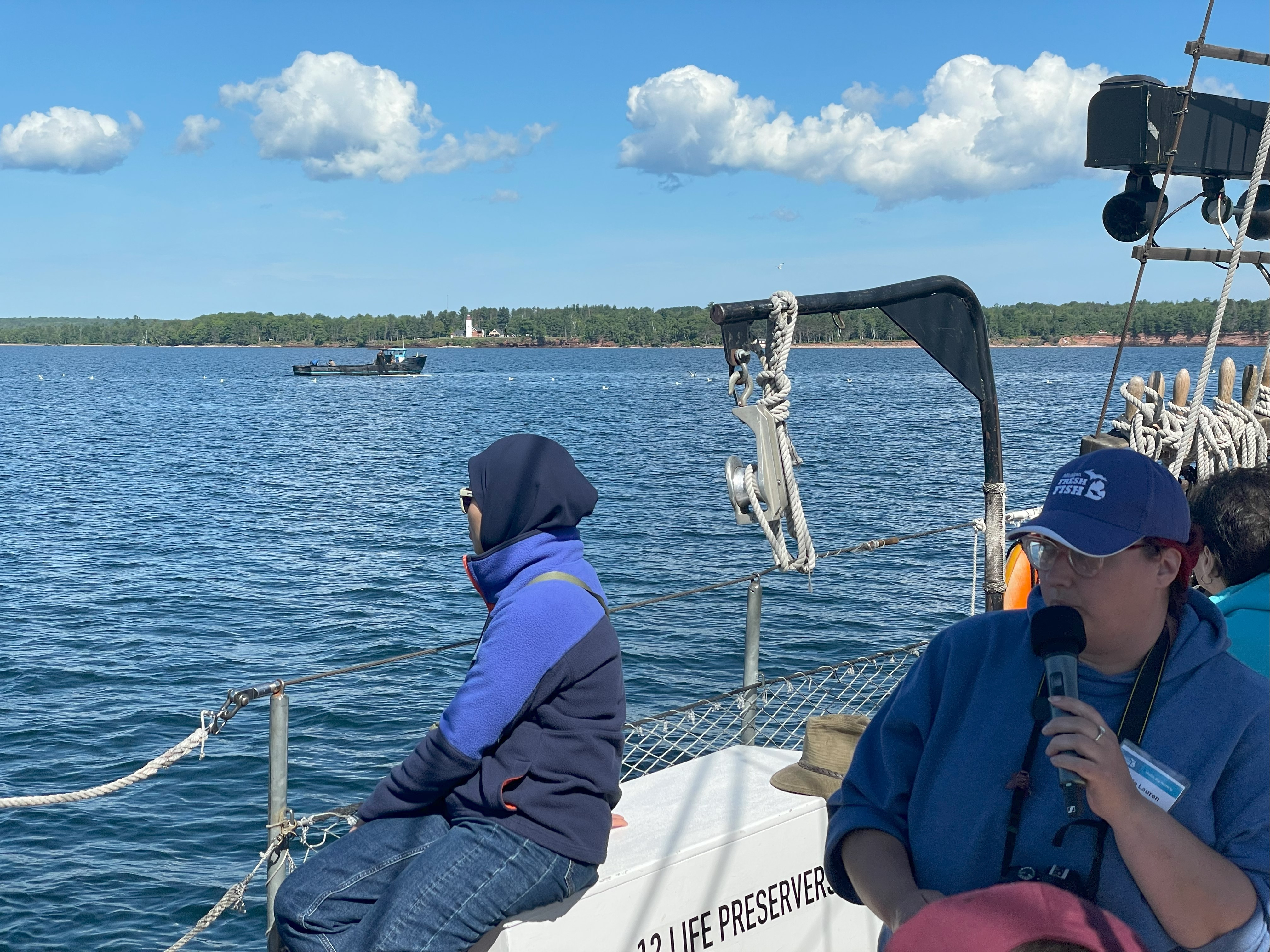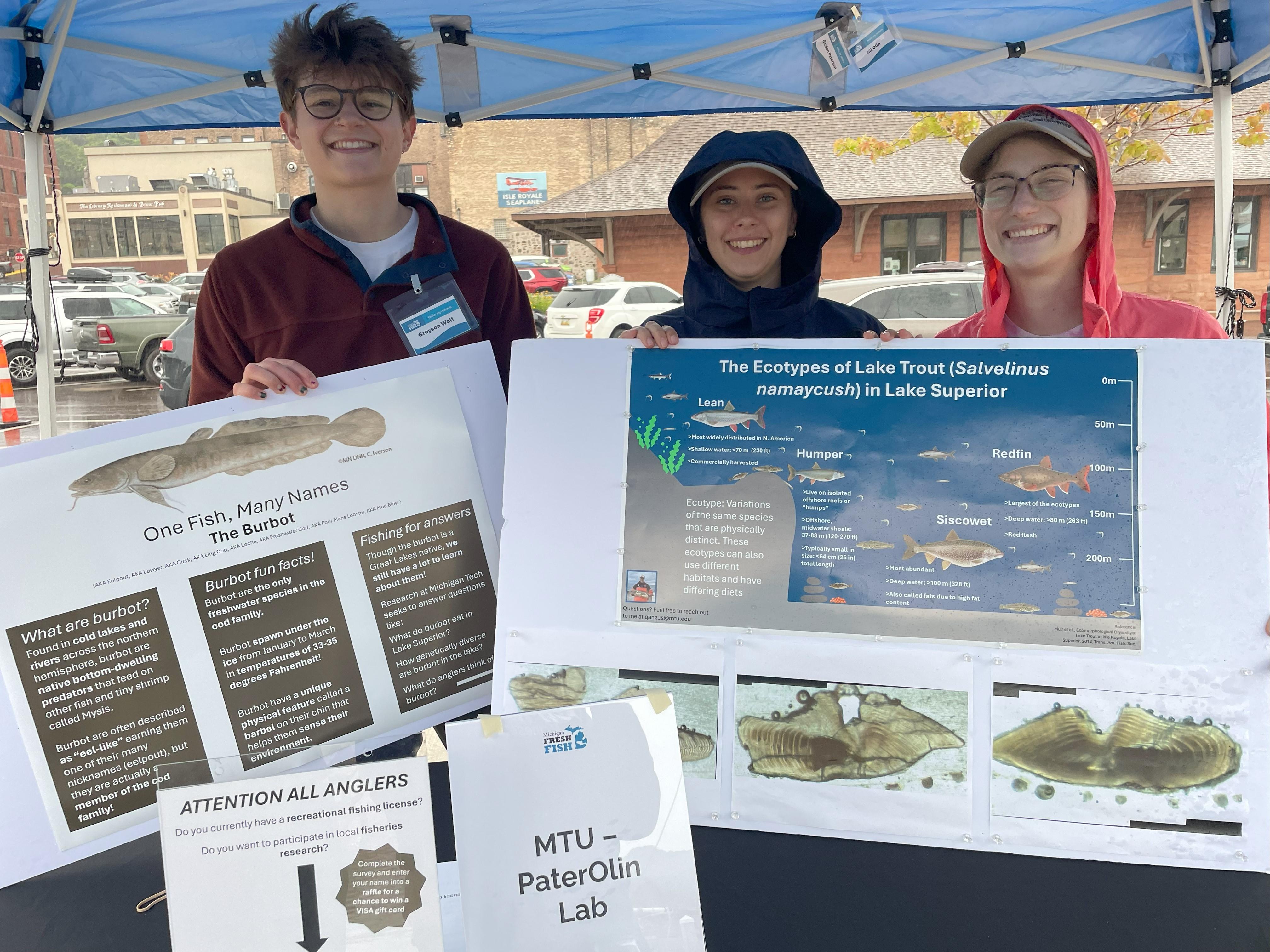Mi Fresh Fish shares fisheries facts – and tasty fish – around the state
Fish frys, on-boat experiences are opportunities to learn about aquaculture, fisheries education for consumers and legislators.

“Pinch me because I can’t believe we’re actually here and doing this.” A participant shared as they sailed across Lake Superior’s Keweenaw Bay during the 2025 Houghton’s Mi Fresh Fish Sail. Inland Seas returned in summer 2025 to partner with Michigan State University Extension and Michigan Sea Grant in the Mi Fresh Fish Feast, a day dedicated to celebrating and bringing together the local fisheries through first a morning sail and then an evening fish fry at the downtown pier in Houghton, Michigan.
Learning on the water
On a July morning, 32 Yoopers and visitors participated in a fish-worthy sail on board the Inland Sea’s tall ship schooner, an educational vessel-based educational group from Suttons Bay, Michigan. During this workshop, participants heard from Keweenaw Bay Indian Community Natural Resource Department (KBIC-NRD) about the origin of our waterways and traditional stories that we may take part in while embracing the culture around us within the 1842 treaty territories.
Sailing towards Keweenaw Bay, the group navigated the waterways of the Portage Canal and also engaged in small group presentations with experts including:
- Inland Seas examining and identifying local phytoplankton that feed our local fish communities;
- Minnesota Sea Grant demonstrating native and non-native species across the decades including a live lamprey demonstration;
- KBIC-NRD offering teachings of reciprocity and relationships with fish from local indigenous peoples;
- and Michigan Sea Grant’s Lauren Stigers describing the state of the world's fisheries as shared by the Food and Agriculture Organization, how aquaculture supplements commercial fishing, and how various values of fish drive social and economic impacts.
Minnesota Sea Grant displays a sea lamprey attached to a lake trout as one of the educational features on the Mi Fresh Fish Sail. Photo: Terra Bowling
The main voyage’s epicenter was in the open waters of Keweenaw Bay when the tall ship schooner sailed right up to and witnessed a live trap-net demonstration of locally harvested fish by a local, tribal commercial fishing business: First Catch Fishing, LLC. While the fishermen and his crew tied lines, pulled up the net, and scooped the fish out onto the boat, a mate was on board the ship describing the process and answering questions from participants about the net, fish, and way of life as commercial fishermen. Many participants were flabbergasted over the area required for a trap net - almost an acre in size! The tall ship schooner, standing 77 feet long, had to stay steady outside the buoys to stay safe. Many questions about the differences between gill net fishing and trap net fishing also arose and were answered by speakers with shared resources such as Michigan Sea Grant’s Nets of the Great Lakes page and handout.

Learning on land
In the afternoon, shoreside participants and other visitors joined together to continue celebrating Mi Fresh Fish with a fish fry. Nearly 250 people celebrated at this educational event that showcased local partners working with all aspects of Michigan’s fisheries.
Visitors were welcomed at the Mi Fresh Fish tent with educational and marketing materials about Mi Fresh Fish, and were able to see live fish at the aquaculture demo tank that were raised at the KBIC-NRD fish hatchery. There were returning vendors from the previous year’s fish fry such as Copper Country Trout Unlimited and MiSTEM, but there were also many new vendors offering new activities and education such as Eat Safe Fish, Copper Country Mental Health, and graduate research students sharing their local fish research from Michigan Technological University.

“We had such a great time last year that we just had to come back!” said a family as they walked up to see the live fish, “the food was awesome as well, so we plan on making our way to the food tent.” To their delight, there was the returning midwest fish boil from last year with Peterson’s Fish Market fish, but with a zesty influence by the chef of Northwoods Test Kitchen. Additionally, visitors could buy smoked fish or raw fish to take home from First Catch Fishing, or wait in line to try a bite of farm-raised walleye with a yummy strawberry salsa.
Education to legislators
The story and education of Mi Fresh Fish was also shared in Lansing, Michigan right outside the state capitol building in June. During the Michigan Fish Producers Association (MFPA) annual fish fry for state legislators, MSU Extension and Michigan Sea Grant provided education about Michigan’s commercial fishing industry. An infographic handout of the 2024 Status of the Industry led to conversations to approximately 300 legislators, legislative aids, and local community members. Many participants loved eating the fish, with some saying it was the best they ever had. The chefs for the day made sure to share that state-licensed fishers are unable to keep any walleye or lake trout they catch. Therefore those that were sampled were Great Lakes fish bought from either Native American fishermen or Canada. Yellow perch from Saginaw Bay and lake whitefish from the upper Great Lakes were also sampled, provided by the commercial fishers.
From small towns up north to neighborhoods in Lansing, Mi Fresh Fish teaches us that local fish is more than just a meal - it’s a celebration of Michigan’s people, places, and community traditions.
Michigan Sea Grant helps to foster economic growth and protect Michigan’s coastal, Great Lakes resources through education, research, and outreach. A collaborative effort of the University of Michigan and Michigan State University and its MSU Extension, Michigan Sea Grant is part of the NOAA-National Sea Grant network of 34 university-based programs.
This work was supported by The Great Lakes Aquaculture Collaborative under award NA22OAR4170627. This article was prepared by Michigan Sea Grant under award NA22OAR4170084 from the National Oceanic and Atmospheric Administration, U.S. Department of Commerce through the Regents of the University of Michigan. The statement, findings, conclusions, and recommendations are those of the author(s) and do not necessarily reflect the views of the National Oceanic and Atmospheric Administration, the Department of Commerce, or the Regents of the University of Michigan.



 Print
Print Email
Email

